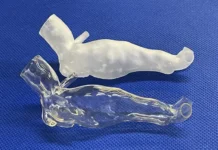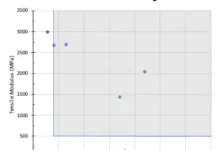By Stephanie Benight, Ph.D., Tactile Materials Solutions LLC, sbenight@tactilems.com;
Callie Higgins, Ph.D. NIST, Colorado School of Mines, callie.higgins@NIST.gov
As additive manufacturing technology matures and 3D-printed parts are incorporated into real-world products, product integrity and long-term materials stability become increasingly important. Highly regulated industries – such as aerospace, automotive and medical device, for example – mandate testing standards that mitigate risk by testing components in a manner relevant to the forces and environmental conditions present in the intended application. Photopolymer AM materials have advanced significantly in recent years with the inclusion of hybrid material technologies, improved UV components and software, enabling material properties that move applications beyond prototyping to small-, medium- and high-volume production. However, standards governing testing of 3D-printed parts made from polymers, and particularly photopolymers, are lacking.
Specific standards that outline key factors for consideration, test specimen form factor, test conditions and other pertinent guidelines for additively manufactured photopolymer materials are needed to satisfy requirements of highly regulated industries. The next best option, which currently is utilized, is to employ standards developed generally for thermoplastics produced by traditional manufacturing methods.
While these standards may be suitable in some instances, they may not be the optimal method for confirming product safety. Standards that take changes induced by the vat photopolymerization printing process into account do not currently exist. Material property changes can occur through differences introduced by the print process, such as layer thickness, interlayer interactions, cure depth and post processing, to name a few. Additional research is needed in this area. To this end, now is the time to ramp up standards activities so photopolymers can indeed be incorporated into production applications with confidence and without delay.
Current photopolymer AM standards efforts include the following:
WK83109 New Guide for Additive Manufacturing – Design –
Vat Photopolymerization 1
This guide proposal proposes a new task on design for vat photopolymer processes in the ASTM F42.04 design subcommittee. Based on the more general ISO/ASTM “Standard Practice/Guide for Design for Additive Manufacturing,” this work is specifically dedicated to vat photopolymer (VPP) processes.
WK78224 New Test Method for Additive Manufacturing –
Vat Photopolymerization – Next Generation Tensile Test Method 2
This next-generation tensile test method will complement traditional tensile test method for polymer parts (e.g., ASTM D412 Types A-F) to accurately characterize mechanical properties of vat photopolymerization additively manufactured parts that are comprised of lattice structures to represent structures that are not 100% dense polymer.
WK82883 New Specification for Additive Manufacturing of Ceramics – Feedstock Materials – Characterization of Ceramic Slurry in Vat Photopolymerization 3
This standard specifies the characterization of ceramic slurry for use as feedstock in vat photopolymerization additive manufacturing (AM) process. The characterization includes the composition and properties of the slurry, such as solids content, dynamic viscosity, particle size distribution, chemical composition, and solid dispersion stability.
These activities are advancing through collaborative efforts by committees of industry, government and academic experts.
What are the standards required for your work utilizing photopolymer AM materials for commercial applications? Let us know! These standards activities are member-driven, and input from active users in varying industries is critical. We would love to hear from you and incorporate them into the current standards activities in vat photopolymerization.
References
- ASTM WK83109, New Guide for Additive manufacturing – Design – Vat Photopolymerization, www.astm.org/workitem-wk83109
- ASTM WK78224, New Test Method for Additive Manufacturing – Vat Photopolymerization – Next Generation Tensile Test Method, www.astm.org/workitem-wk78224
- ASTM WK82883, New Specification for Additive manufacturing of ceramics – Feedstock materials – Characterization of ceramic slurry in vat photopolymerization, www.astm.org/workitem-wk82883






